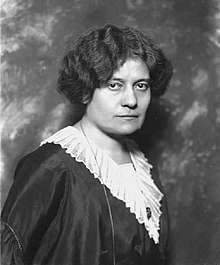Ada Negri
Ada Negri (3 February 1870 – 11 January 1945) was an Italian poet and writer.

Biography
Ada Negri was born in Lodi, Italy into an artisan family to Giuseppe Negri alongside his wife Vittoria Cornalba. She attended Lodi’s Normal School for Girls and earned an elementary teacher’s diploma. At eighteen, she took a position as schoolteacher in the village of Motta Visconti,[1] on the Ticino, near Pavia. Her first volume of lyrics, Fatalità, (1892) confirmed her reputation as a poet, and led to her appointment to the normal school at Milan. Her second book of poems, Tempeste (1896), tells the helpless tragedy of the forsaken poor.[2]
On 28 March 1896, she married industrialist Giovanni Garlanda of Biella,[3] who had fallen in love with her from reading her poetry. By 1904 they had daughters, Bianca and Vittoria. The latter died in infancy. In 1913, Negri separated from her husband and moved to Switzerland with Bianca. Afterwards, she constantly moved. She was a frequent visitor to Laglio on Lake Como,[4] where she wrote her only novel, an autobiographical work, Stella Mattutina (Morning Star), published in 1921, and in English in 1930. During an extended stay on Capri that began in March 1923, she wrote I canti dell'isola.
She became the first woman member of the Italian Academy in 1940. That achievement, however, also stained her later reputation since members of the Academy had to swear loyalty to the Fascist regime and were rewarded by it with various material benefits. On 11 January 1945, her daughter Bianca found Negri dead in her studio in Milan. She was 74 years old.[5]
Her work was widely translated during her lifetime, with individual poems published in newspaper in the U.S. and elsewhere.
The actress Pola Negri (born Barbara Apolonia Chałupec), adopted the stage surname "Negri" in emulation of the poet. The actress Paola Pezzaglia was the ideal interpreter of her poetry on stage.[6]
Criticism
Benedetto Croce, called her work "facile, tearful, completely centered on the melodiousness and readiness of emotions — poetics that are somewhat melancholy, idyllic-elegiac." He dismissed her, writing that a "lack or imperfection in artistic work is most particularly a feminine flaw (difetto femminile). It is precisely woman’s maternal instinct, her ‘stupendous and all-consuming’ ability to mother a child that prevents her from successfully giving birth to a fully realized literary work."[7]
However, other critics saw her as "someone whose vision focused on the toils of life in a way few other writers did during those troubled times. Her naturally lyrical soul knew, in the major parts of her works, how to transform with an imprint of originality the sufferings, the bitterness, the joys of an entire generation."[8] She was described as a writer who "abolished established conventions, and shaped her lyrics according to the rhythms of the heart, in sync to whatever it is that makes the winds blow, gives rise to the waters and pulse to the stars — a poetry infinitely free, capricious and precise."[9]
Her work and her life continued to be haunted by the injustice of life, and she even refused to allow her final volume of poetry to be published until World War II ended. Like many Italian writers of this period her reputation after 1945 suffered from being associated with the Fascist movement, having received the Mussolini Prize in 1931.[10] The prize was funded by Corriere della Sera.[10]
Works
Poetry
- Fatalità (1892)
- Tempeste (1896)
- Maternità (1904)
- Dal profondo (1910)
- Esilio (1914)
- Il libro di Mara (1919), translated into English by Maria A. Costantini and published as The Book of Mara by Italica Press (2011)
- I canti dell’isola (1925), translated into English by Maria A. Costantini and published as Songs of the Island by Italica Press (2011)
- Vespertina (1930)
- Il dono (1936)
- Fons amoris (1946) published posthumously
Prose
- Le solitarie (1917)
- Orazioni (1918)
- Stella mattutina (1921), publishing in English as Morning Star (1930)
- Finestre alte (1923)
- Le strade (1926)
- Sorelle (1929)
- Di giorno in giorno (1932)
- Erba sul sagrato (1939)
- Oltre (1947) published posthumously
References
- Maurer, Doris and Arnold. Guida letteraria dell'Italia (Parma: Ugo Guanda Editore, 1993), p. 90.
-

- Marshall, Beatrice . "Ada Negri", The Academy (1 December 1900), p. 522.
- villa-negri.com/location.php Archived 7 October 2010 at the Wayback Machine; accessed 12 June 2014.
- Profile of Ada Negri, siamodonne.it; Retrieved 12 June 2014. (in Italian)
- Archivio Pezzaglia-Greco, chapter 3.
- Re, Lucia, "Futurism and Fascism, 1914–1945," in A History of Women’s Writing in Italy, edited by Letizia Panizza and Sharon Wood (Cambridge: Cambridge University Press 2000), pp. 190–191.
- Schilirò, Vincenzo. L'Itinerario Spirituale di Ada Negri (Milano: Istituto Propaganda Libraria, 1938), pp. 17–18.
- Battaglia, Filippo Maria. "Una Calliope passionaria", Liberal, 22 January 2009, p. 18.
- Ruth Ben-Ghiat (2001). Fascist Modernities: Italy, 1922-1945 (PDF). Berkeley: University of California Press. Archived from the original (PDF) on 29 December 2014. Retrieved 29 December 2014.
Further reading
- "Ada Negri" (in Italian). Italia Donna.
- Bibliography